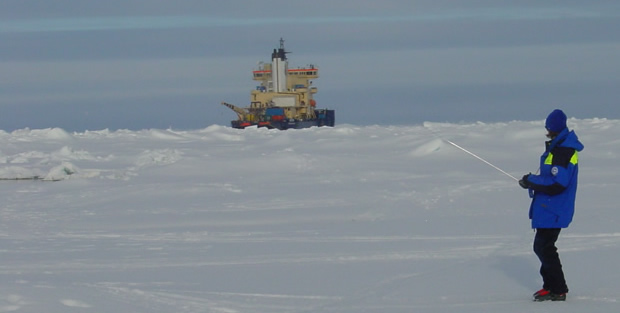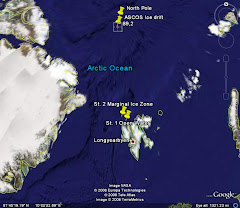This morning at 0615, we were visited by a polar bear seen sleeping about 50m behind the ship. Sara de la Rosa Hohn, who spotted, it will tell us the story. This delayed ALL activities on ice for the morning.
By 12:00, we are at 87o 25.15N 08o 09.04.0W; air temperature -0.6C; winds 4.5-7 m/s; drifting south at 0.1 knots. BUT, the sun came out!! We can see blue sky and shadows for the first time in days! The snow has acquired shades of blue and the open water of the lead glows like a jewel. The lead is open to its widest extension today, almost 1 km wide. Monica went to the lead today; it was her first chance to see the field operations there.
One of the big science questions we have is how does the organic material present in the surface microlayer and subsurface water make it into the air? In open sea water, the wind stirs up the surface, waves form and break, spray and bubbles are generated. Here in the pack ice, if it gets windier then the open leads simply close for the most part, with very little spray visible. Are there bubbles in the water? If so, what size, how many, how frequent? ASCOS has deployed a bubble camera at the lead (G de Leeuw- Finnish Meteorological Institute, operated by Sarah Norris- U Leeds and Andy Hind- Bigelow) to capture images of bubbles rising to the surface. There are bubbles!! The next step is to capture organic material that is available to be "sprayed" into the air. To this effect we have 2 floating systems, the "Bubble Buoy" and the "Bubble Cat", that are simulating the spray by using an air pump that "bubbles" the water and the spray is then collected onto different types of filters for chemical and microscope analyses. Monica spent her time at the lead conducting such experiments, as well as driving the remote controlled surface microlayer boat samplers.
Two seals have visited the lead; today both followed the small remote controlled microlayer sampling boat and the operators had fun following the seals with the boat while slowly sampling. One of the seals would stick out the neck and even more of its body out of the water to see what was going on.
Then, we had a helicopter rescue! The battery on the small microlayer sampler ran out and/or the boat was too far away for an effective control by the operator such that the engine no longer responded; the wind pushed it and it got tangled in the ice. Johan sailed the large sampling boat to the rescue but it got tangled on loose ice on the other side of the lead and now we had 2 lost boats! The helicopter picked up Johan and flew him to the other side of the lead. The small boat was picked up by hand and placed inside the heli. The large boat was tied to a rope and carefully lifted by the heli over the lead and into the ice while Johan waited. Then all people and boats were re-united on the camp side.
Saturday, August 23, 2008
Subscribe to:
Post Comments (Atom)






No comments:
Post a Comment